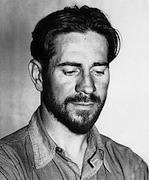RICKETTS, EDWARD F[LANDERS]. (1897-1948). Edward F. Ricketts, marine biologist and ecologist, was John Steinbeck’s collaborator on Sea of Cortez (1941) and the model for “Doc,” protagonist of Steinbeck’s Monterey novels Cannery Row (1945) and Sweet Thursday (1954), and for “Friend Ed,” one of four principal characters in Steinbeck’s play-novelette Burning Bright (1950). Born on the west side of Chicago, Ricketts was haphazardly educated at Illinois State Normal School and the University of Chicago. He took no undergraduate degree but completed ten quarters of zoology.
In 1923 Ricketts moved to California, where he became owner of a biological supply house, Pacific Biological Laboratory, eventually situated on the Monterey waterfront in the area known as “Cannery Row.” Ricketts’ business involved collecting marine organisms for sale to college and university laboratories. He found in California’s intertidal zones a relatively unstudied flora and fauna, and his research led to his time-honored handbook, Between Pacific Tides (1939), now in its fifth revised and updated edition. Originally written with junior author Jack Calvin, Between Pacific Tides is both ecological and inductive in its method, with animals grouped according to their characteristic habitats and in order of their commonness–a revolutionary approach in 1939 and one still relevant.
Ricketts was as passionately interested in the arts and humanities as in the sciences, and his lab became a magnet not only for biologists at work at Stanford University’s nearby Hopkins Marine Station but also for artists, political radicals, and intellectuals of every stripe. Jungian psychologist Joseph Campbell and writer Henry Miller were among the habitues of Pacific Biological, and the work of the reclusive poet Robinson Jeffers, who also lived nearby, was one of many topics for discussion. Ricketts’ most enduring impact, however, was on Steinbeck, who from 1930 until 1936 was almost constantly in his company. Five years younger than Ricketts, Steinbeck was profoundly influenced by the marine biologist’s ecological vision–as may be seen in the social principles of mutual interdependence advanced in Steinbeck’s The Grapes of Wrath (1939).
In 1940 Steinbeck and Ricketts chartered Captain Tony Berry and his purse seiner, the Western Flyer, for an expedition to Mexico’s Gulf of California, also known as the Sea of Cortez, where they spent six weeks collecting marine organisms. The scientific results of the expedition included the description of more than fifty species previously unknown to science, as well as significant range extensions for many known organisms; specimens collected by Ricketts and Steinbeck are preserved at the California Academy of Science in San Francisco.
The published result of the voyage was Steinbeck and Ricketts’ Sea of Cortez (1941). The second half of the book is scientific treatise: an annotated phyletic catalog and bibliography of the species encountered and illustrations of the organisms. This portion of Sea of Cortez is largely the marine biologist’s, although Steinbeck worked at the collecting and sorting of animals and helped review the scientific literature. The first half of the book, the “Log from the Sea of Cortez,” combines marine biology, mysticism, humor, adventure, and speculative metaphysics in a remarkable account of the expedition. Apparently, Steinbeck wrote the “Log” from Ricketts’ expedition journal and unpublished essays, using a scheme of organization and collaboration developed by both men.
Ricketts’ coauthorship of the “Log” was obscured after his death, when Viking Press dropped the scientific portion of Sea of Cortez and published The Log from the Sea of Cortez (1951) as a “new” book, with Steinbeck’s name alone on the cover and in the headers. Ricketts’ name remained on the title page, and Steinbeck’s eulogy, “About Ed Ricketts,” served as preface to the volume. Although this publishing gambit was, in part, an attempt to increase sales and bring Ricketts’ ideas to a wider audience, it encouraged the now-widespread misconception that the biologist was responsible solely for the excised scientific treatise on the marine organisms and that The Log from the Sea of Cortez was Steinbeck’s alone.
Ricketts served as the model for “Doc,” protagonist of Steinbeck’s novel Cannery Row (1945). Marine biologist and tide-pool philosopher, half goat and half Christ, “Doc” is high priest to the dispossessed bums and whores of Monterey’s waterfront. In 1954, Steinbeck published a sequel to Cannery Row, Sweet Thursday, a lighter and more sentimental comedy about Doc’s courtship of a prostitute named Suzy.
Ricketts was also the basis for “Friend Ed,” a character in Steinbeck’s poorly received play-novelette Burning Bright (1950). “Friend Ed” appears variously in three acts as a circus clown, farmer, and finally a freighter captain who is confidant to Joe Saul, an aging man who fears that he is sterile but longs for a child. Saul’s cherished wife, Mordeen, becomes pregnant by another man, Victor, to give Saul the child he craves. When Victor threatens to betray his fathership of the child to Saul, “Friend Ed” in his freighter captain persona stabs Victor to death and tosses him overboard. After the murder, when Saul receives incontrovertible medical evidence of his sterility, “Friend Ed” persuades him to forgive Mordeen and accept the child as a gift of love, then sails away on his ship.
Ricketts died in 1948 of injuries received when his car was struck on the railroad tracks in Monterey by the Del Monte Express. His death preempted a second scientific expedition that he and Steinbeck had been planning, to the Queen Charlotte Islands off the coast of British Columbia.
Sea of Cortez (1941)
Between Pacific Tides (1939)
Archive.org
Google Book Search
keywords: white, male

